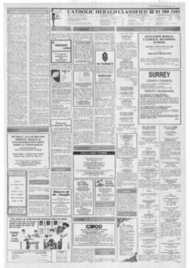Page 2, 20th September 1985
Page 2

Report an error
Noticed an error on this page?If you've noticed an error in this article please click here to report it.
Tags
Share
Related articles
Salvador Church Workers Arrested
Plea For Improvements In Salvadorian Camps
Englishmen Rescue Salvador Refugees
Cafod Director Tells Of Women And Babies Living Underground
Chitnis Back In London
A social fabric rent asunder
TIIE LAST two weeks were spent in El Salvador, Honduras and Nicaragua to get a better sense of numbers, living conditions and outlook for Salvadoran refugees and internally displaced persons.
I visited refugee camps in San Salvador and at Mesa Grande in Honduras, and talked to other refugees and displaced persons and people who worked with them.
We must see the refugee issues in the United States as part of a broader problem and strategy involving all of Central America, as well as Mexico.
Just to elaborate one point, the living conditions and the insecurity which are the lot of the refugees in the United States, harsh as they are — are far less than those of the ever greater number of refugees and displaced persons south of our border, with the sole exception of the relatively small number in Nicaragua. (Unfortunately Nicaragua, because of its small population and the economic disruption caused by the Washington-financed war, is unable to help a larger number.)
A token number find partial protection in refugee camps, inside and outside the country, enough to give an appearance that the governments (including that of the United States) are concerned about the humantragedy.
But the overwhelming majority live on the charily of people as poor as themselves, sustained only by their hope based on the new understanding of the Gospel provided by Vatican II, Medellin, Puebla and the Christian base communities.
The five-year war in El Salvador is tearing the social fabric apart. Although several factors have changed, they have not significantly altered the balance. In consequence we can expect the stalemate to continue indefinitely. There has been some reduction in the number of combatant casualties, and the death squads (while still in position and ready to strike at any moment) are operating at a very low level in the cities.
However, casualties are worsening with the increased air power and ground sweeps by the army, designed to drive the civil population from areas in which they provide the social and economic base for the popular forces. Continuation of this process will mean that El Salvador will cease to be a structured, civilised society, a people with social adhesion and a sense of common destiny.
In spite of all their sufferings, the morale of the poor and their identification with the FDR-FMLM remains solid. The Army which is the protector both of Duarte's government and the extreme right (in spite of the very different objective of these two groups) would crumble almost immediately if the United States did not continue to escalate its military, financial and diplomatic support.
Only the United States can end the war, and it can do this only by ending its support to the unpopular side.
The Duarte government is a satellite of Washington which persuades it to maintain its
tenuous coalition with the extreme right when in fact its only long term hope would be to recognise that the extreme right is its enemy and the popular forces its friend.
In Nicaragua, the economic impact of the "contra" attacks is significantly more noticeable. Almost everything is missing or available in minimum quantities. Transportation is particularly hard hit reflecting lack of tyres and spares. Far fewer soldiers and militia are seen in Managua or in the villages (1 got out this lime to Matagalpa) titan was the case since 1979. The specific reason is that they are mobilised on the Honduran and Costa Rican borders to repel "contra" attacks. The psychological symbolism is even more important. The Government has no fear of internal opposition because it trusts the civilian population.
The conflict within the Catholic Church in El Salvador and Nicaragua has hardened. In both countries, the bishops are now openly ranged as a group (although their individual positions are more ambiguous) on the side of the wealthy and against any significant social change.
The majority of the priests and a large majority of the women religious, together with the numerous and important Christian-base communities, are as firmly on the side of the poor and the oppressed. 1 had several talks in Nicaragua with Bishop Pedro Casaidaliga of Sao Felix in the Amazon, Since the retirement of Dom Helder Camara of Recife (Brazil) and Bishop Mendez Arceo of Cuernavaca (Mexico), Casaldaliga has become the principal leader of the progressive bishops of Latin America.
For the first time since he was named bishop 22 years ago, he left his diocese to be with Fr Miguel D'Escoto during his fast protest against United States intervention in Nicaragua.
Casalchiliga's analysis is that reactionary elements in the Vatican, with the Pope's approval, have encouraged the Nicaraguan and Salvadoran bishops to take the line they have adopted, the ratiostal6 being the neo-MeC'arthyite argument that any change in the status quo inevitably ends up in a communist dictatorship.
This attitude of the bishops for whom people traditionally have great respect is causing much suffering, and many young people are simply forsaking any religious practice. The reaction of others, however, is to deepen their commitment to the Christian-base communities in which they find a religion that corresponds to their human and spiritual needs.
In Nicaragua, in El Salvador, and in Honduras, the morale of those struggling to defend the liberties they have won or the liberties they are determined to win remains incredibly high. The power of the poor, the commitment of the poor, the faith of the poor, which is at the same time a human and divine faith, are incomprehensible to those who believe that material strength can achieve whatever objectives they desire.
blog comments powered by Disqus











